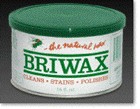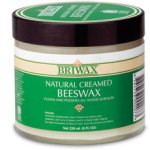Uses of Beeswax:

(facts that you probably never really wanted to know but here they are anyway)
Briwax uses a blend of beeswax and carnauba wax. The beeswax in Briwax primarily comes from Australia and New Zealand. Carnauba wax is found only in Brazil.
A lot of folks ask us if Briwax is safe for cutting boards and for children’s furniture. We always respond that beeswax is inert, which basically means it is food safe and really effects nothing. It is just wonderful stuff. Once the solvent evaporates, with Briwax, you are left with two natural waxes – beeswax and Carnuba. Always make sure your wax has beeswax in it.
Here are some of the uses and applications of beeswax that you may find interesting.
- Candles
- Lip balm
- Cosmetics
- Medical creams
- Waterproofs shoes and fishing lines
- Wax for skis, toboggans and bow strings
- Used as a coating for cheese
- Of course, furniture polish (Briwax)
- Soap making
- Beard and mustache wax
- Crayons
- A seal for jams and jellies
- Leather waterproofing
- “Lost –wax” method of metal casting (Class rings and Golf Clubs)
- Embalming procedures (Mummifying)
- Polishes
- Wood filler
- Tack cloths
- Glass etching

Technical Facts about beeswax.
A stable chemical makeup that essentially remains constant over time
Insoluble in water, density 0.95
Becomes brittle below 10º C (52º F)
Becomes soft and pliable above 25º C (82ºF)
Melting point 65 C (highest melting point of any known wax, 162ºF)
Beeswax does not deteriorate over time (usable beeswax found in ancient tombs)

No comments:
Post a Comment